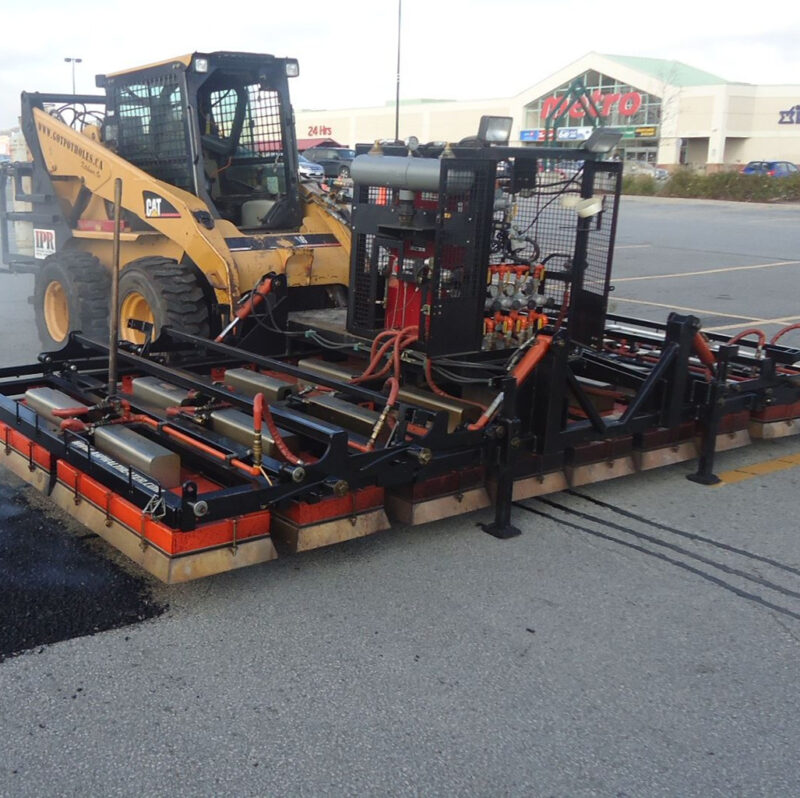Asphalt surfaces in Detroit face heavy wear and tear due to the constant traffic and harsh weather conditions, especially during the cold months. Over time, cracks and potholes form, making roads, parking lots, and driveways not only unsightly but also hazardous. Infrared asphalt patching is a cutting-edge solution that addresses these issues efficiently and effectively. This method of repair has become increasingly popular in Detroit, Michigan, due to its ability to provide durable, long-lasting fixes even in the toughest winter conditions.
In this article, we will explore the many benefits of infrared asphalt patching, particularly its use in cold-weather repairs, and why it is an ideal solution for Detroit’s asphalt maintenance needs.
What is Infrared Asphalt Patching?
Infrared asphalt patching is a specialized process that involves using infrared technology to heat and soften damaged asphalt. The method allows workers to blend new asphalt with the existing surface seamlessly, resulting in a repair that is smooth, level, and nearly invisible. This process is much faster and more efficient than traditional patching methods, making it an excellent choice for municipalities and property owners looking for timely, cost-effective repairs.
The technique begins with an infrared heater being placed over the damaged area to heat the asphalt to a workable temperature. Once the asphalt is soft, any broken or deteriorated material is removed, and new asphalt is added. The new and old materials are then blended and compacted to create a seamless surface that’s as strong as the original pavement.
Why Infrared Asphalt Patching is Ideal for Detroit’s Cold Climate
The winter months in Detroit can be harsh, with freezing temperatures, ice, and snow taking a toll on asphalt surfaces. Traditional asphalt repair methods are often not feasible during the winter, as the cold temperatures prevent new asphalt from bonding properly with the existing surface. This is where infrared asphalt patching shines.
Infrared patching can be performed in cold weather, making it a year-round solution for asphalt maintenance in Detroit. The infrared technology used to heat the asphalt allows for repairs to be made even when the surface is frozen or covered with snow. This is a significant advantage for property owners and municipalities, as waiting until spring to repair potholes and cracks can lead to further damage, higher repair costs, and increased safety risks.
The Benefits of Infrared Asphalt Patching
1. Durability and Longevity
One of the primary benefits of infrared asphalt patching is the durability of the repair. By heating the existing asphalt and blending it with new material, infrared patching creates a repair that is as strong as the original pavement. This seamless integration means there are no weak points or edges where water can seep in and cause further damage, which is especially important in Detroit’s freeze-thaw cycle.
The repairs made using infrared technology are long-lasting, making it a cost-effective solution for both small and large repairs. Whether it’s fixing a few cracks or filling in potholes, infrared patching ensures the repaired area can withstand the city’s heavy traffic and weather conditions for years to come.
2. Faster Repair Time
Another significant advantage of infrared asphalt patching is the speed at which repairs can be completed. Traditional asphalt patching methods can be time-consuming and require extended closures of roads or parking lots. Infrared patching, on the other hand, allows for repairs to be completed in a fraction of the time.
Because the infrared heating process softens the existing asphalt without the need for extensive removal or replacement, the total repair time is greatly reduced. Most infrared patches can be completed in less than an hour, allowing roads and parking lots to reopen quickly, minimizing disruption for drivers and pedestrians.
3. Environmentally Friendly
Infrared asphalt patching is also an environmentally friendly option. Traditional asphalt repairs often require the complete removal and disposal of the damaged material, which contributes to landfill waste. With infrared patching, much of the existing asphalt is reused, reducing the need for new materials and minimizing waste.
Additionally, because infrared patching requires fewer resources and less energy than traditional methods, it has a smaller carbon footprint. In a city like Detroit, where sustainability is becoming increasingly important, infrared asphalt patching offers an eco-friendly alternative to conventional asphalt repair methods.
4. Cost-Effective
For property owners and municipalities looking to stretch their budgets, infrared asphalt patching is a highly cost-effective solution. The speed and efficiency of the process reduce labor costs, while the reuse of existing materials lowers the cost of new asphalt. Furthermore, because infrared repairs last longer than traditional patches, property owners save money on future repairs and maintenance.
In Detroit, where freezing temperatures and heavy traffic can lead to frequent asphalt damage, choosing a repair method that provides long-term results at a lower cost is essential. Infrared patching offers a reliable, budget-friendly solution for maintaining the city’s asphalt surfaces.
5. Minimal Disruption
Infrared asphalt patching causes minimal disruption to the surrounding area. Because the process is fast and does not require the removal of large amounts of asphalt, it results in fewer closures and less noise than traditional repair methods. This is particularly beneficial in busy areas like downtown Detroit, where keeping roads and parking lots open is crucial for businesses and commuters.
Why Infrared Asphalt Patching is Crucial in Winter Months
As mentioned earlier, Detroit’s harsh winter weather can make traditional asphalt repairs nearly impossible. Cold temperatures make it difficult for new asphalt to properly bond with the old surface, leading to weak, temporary repairs that may not last through the season.
Infrared asphalt patching, however, is designed to work in colder conditions. The infrared heaters used in the process can bring frozen asphalt to a workable temperature, allowing for repairs even in freezing weather. This ability to perform repairs during the winter months is invaluable in Detroit, where waiting for warmer weather can lead to dangerous potholes and cracks that only worsen over time.
By addressing asphalt damage as soon as it occurs, even during the winter, property owners can prevent more extensive and costly repairs in the spring. Infrared patching ensures that roads, parking lots, and other surfaces remain safe and functional throughout the winter, reducing the risk of accidents caused by damaged pavement.
For property owners and municipalities in Detroit, Michigan, infrared asphalt patching offers an innovative, cost-effective, and environmentally friendly solution for maintaining asphalt surfaces. Its ability to create durable, long-lasting repairs, even in cold weather, makes it an ideal choice for Detroit’s harsh winters. By opting for infrared patching, you can address asphalt damage quickly and efficiently, reducing the risk of further deterioration and ensuring the safety of your property year-round.
If you’re looking to keep your Detroit property in top condition, consider infrared asphalt patching as your go-to solution for asphalt repair. Reach out to your local provider today to learn more about how this advanced technology can benefit your property.

